ORGM5000 - Strategy Change: Analyzing Traditional Strategy
VerifiedAdded on 2023/06/14
|15
|3052
|386
Essay
AI Summary
This essay explores the shift towards business models in strategic management, driven by the limitations of traditional approaches. It examines factors to consider in strategy formulation, including external analysis, Porter’s Five Forces, and value chain analysis. The essay critiques traditional strategic approaches like design, planning, and positioning, highlighting their shortcomings in today's dynamic business environment. It then discusses how business models address these limitations by integrating internal and external perspectives. Finally, it presents recent approaches to strategy formulation that complement business models, such as managed innovation, strategic alignment, industry foresight, and developing core competencies. The essay emphasizes the importance of organizational readiness to adapt to new strategies.
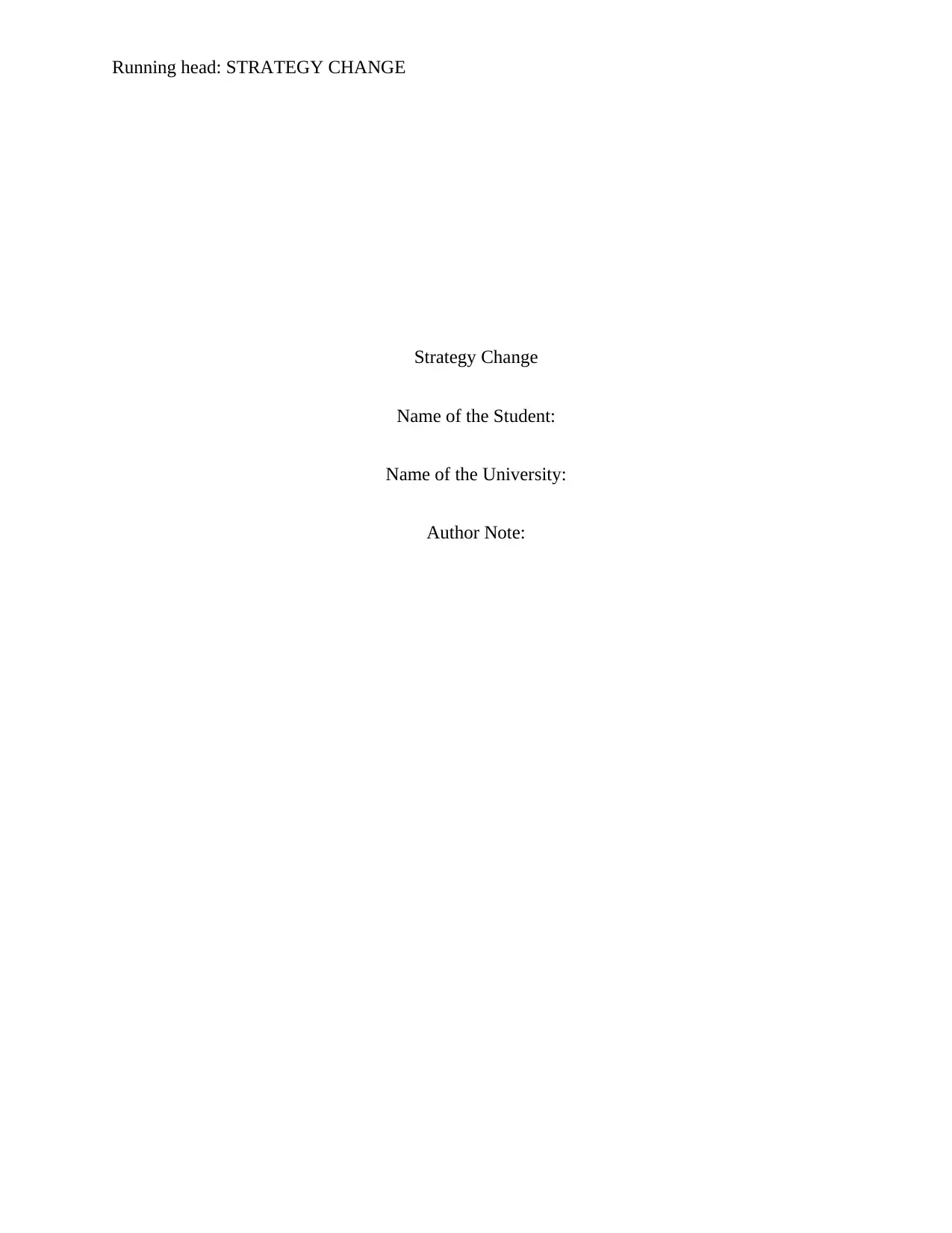
Running head: STRATEGY CHANGE
Strategy Change
Name of the Student:
Name of the University:
Author Note:
Strategy Change
Name of the Student:
Name of the University:
Author Note:
Paraphrase This Document
Need a fresh take? Get an instant paraphrase of this document with our AI Paraphraser
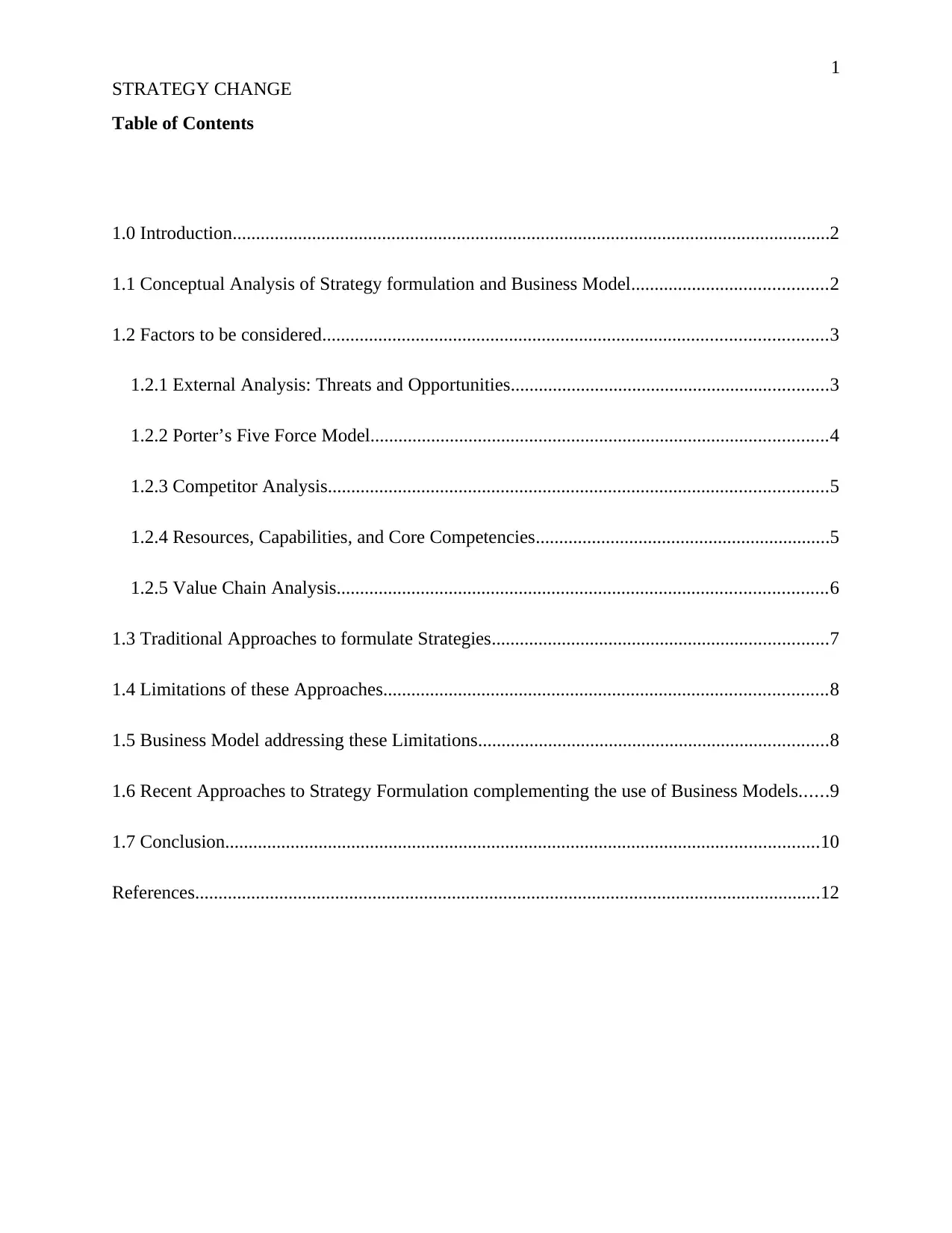
1
STRATEGY CHANGE
Table of Contents
1.0 Introduction................................................................................................................................2
1.1 Conceptual Analysis of Strategy formulation and Business Model..........................................2
1.2 Factors to be considered............................................................................................................3
1.2.1 External Analysis: Threats and Opportunities....................................................................3
1.2.2 Porter’s Five Force Model..................................................................................................4
1.2.3 Competitor Analysis...........................................................................................................5
1.2.4 Resources, Capabilities, and Core Competencies...............................................................5
1.2.5 Value Chain Analysis.........................................................................................................6
1.3 Traditional Approaches to formulate Strategies........................................................................7
1.4 Limitations of these Approaches...............................................................................................8
1.5 Business Model addressing these Limitations...........................................................................8
1.6 Recent Approaches to Strategy Formulation complementing the use of Business Models......9
1.7 Conclusion...............................................................................................................................10
References......................................................................................................................................12
STRATEGY CHANGE
Table of Contents
1.0 Introduction................................................................................................................................2
1.1 Conceptual Analysis of Strategy formulation and Business Model..........................................2
1.2 Factors to be considered............................................................................................................3
1.2.1 External Analysis: Threats and Opportunities....................................................................3
1.2.2 Porter’s Five Force Model..................................................................................................4
1.2.3 Competitor Analysis...........................................................................................................5
1.2.4 Resources, Capabilities, and Core Competencies...............................................................5
1.2.5 Value Chain Analysis.........................................................................................................6
1.3 Traditional Approaches to formulate Strategies........................................................................7
1.4 Limitations of these Approaches...............................................................................................8
1.5 Business Model addressing these Limitations...........................................................................8
1.6 Recent Approaches to Strategy Formulation complementing the use of Business Models......9
1.7 Conclusion...............................................................................................................................10
References......................................................................................................................................12
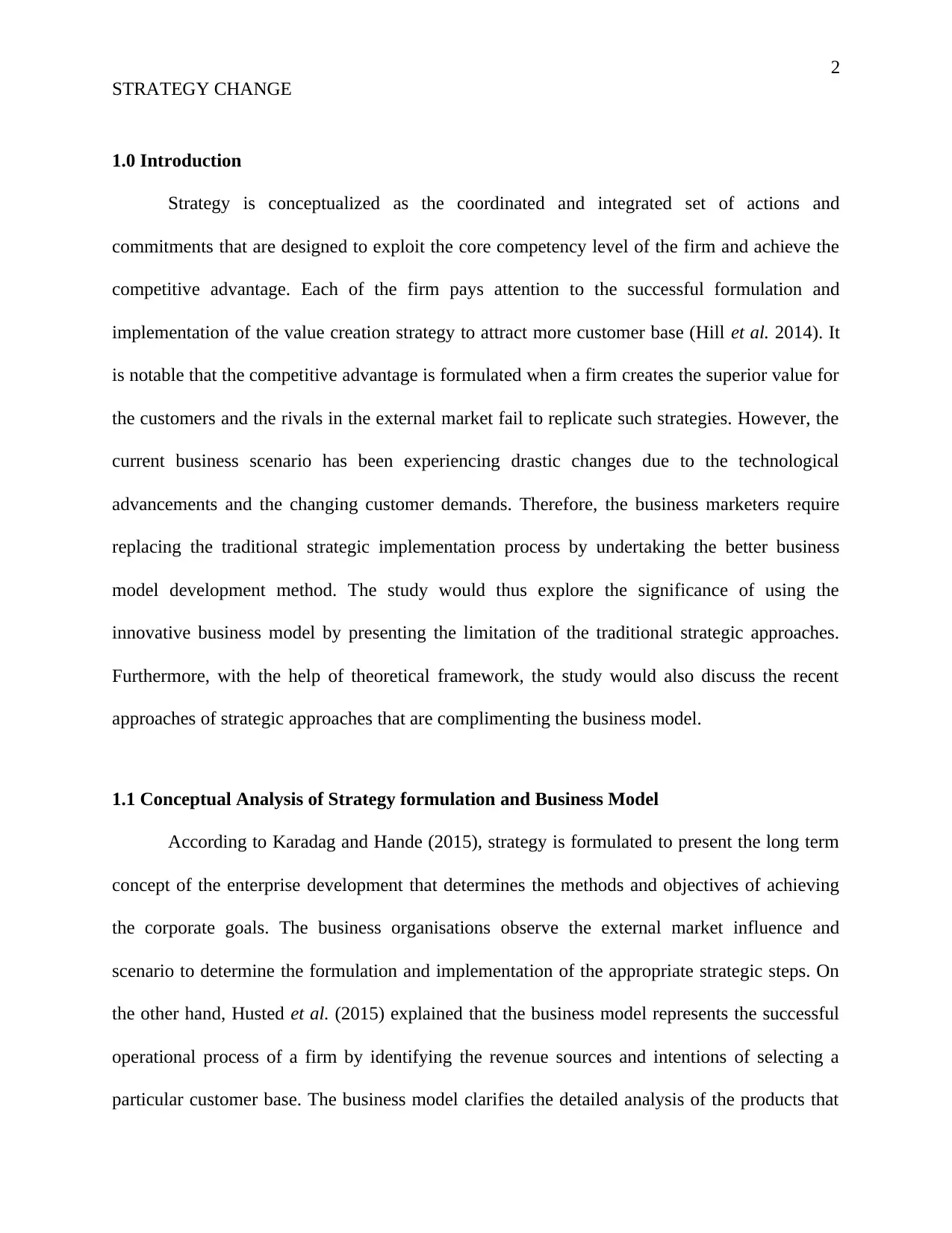
2
STRATEGY CHANGE
1.0 Introduction
Strategy is conceptualized as the coordinated and integrated set of actions and
commitments that are designed to exploit the core competency level of the firm and achieve the
competitive advantage. Each of the firm pays attention to the successful formulation and
implementation of the value creation strategy to attract more customer base (Hill et al. 2014). It
is notable that the competitive advantage is formulated when a firm creates the superior value for
the customers and the rivals in the external market fail to replicate such strategies. However, the
current business scenario has been experiencing drastic changes due to the technological
advancements and the changing customer demands. Therefore, the business marketers require
replacing the traditional strategic implementation process by undertaking the better business
model development method. The study would thus explore the significance of using the
innovative business model by presenting the limitation of the traditional strategic approaches.
Furthermore, with the help of theoretical framework, the study would also discuss the recent
approaches of strategic approaches that are complimenting the business model.
1.1 Conceptual Analysis of Strategy formulation and Business Model
According to Karadag and Hande (2015), strategy is formulated to present the long term
concept of the enterprise development that determines the methods and objectives of achieving
the corporate goals. The business organisations observe the external market influence and
scenario to determine the formulation and implementation of the appropriate strategic steps. On
the other hand, Husted et al. (2015) explained that the business model represents the successful
operational process of a firm by identifying the revenue sources and intentions of selecting a
particular customer base. The business model clarifies the detailed analysis of the products that
STRATEGY CHANGE
1.0 Introduction
Strategy is conceptualized as the coordinated and integrated set of actions and
commitments that are designed to exploit the core competency level of the firm and achieve the
competitive advantage. Each of the firm pays attention to the successful formulation and
implementation of the value creation strategy to attract more customer base (Hill et al. 2014). It
is notable that the competitive advantage is formulated when a firm creates the superior value for
the customers and the rivals in the external market fail to replicate such strategies. However, the
current business scenario has been experiencing drastic changes due to the technological
advancements and the changing customer demands. Therefore, the business marketers require
replacing the traditional strategic implementation process by undertaking the better business
model development method. The study would thus explore the significance of using the
innovative business model by presenting the limitation of the traditional strategic approaches.
Furthermore, with the help of theoretical framework, the study would also discuss the recent
approaches of strategic approaches that are complimenting the business model.
1.1 Conceptual Analysis of Strategy formulation and Business Model
According to Karadag and Hande (2015), strategy is formulated to present the long term
concept of the enterprise development that determines the methods and objectives of achieving
the corporate goals. The business organisations observe the external market influence and
scenario to determine the formulation and implementation of the appropriate strategic steps. On
the other hand, Husted et al. (2015) explained that the business model represents the successful
operational process of a firm by identifying the revenue sources and intentions of selecting a
particular customer base. The business model clarifies the detailed analysis of the products that
⊘ This is a preview!⊘
Do you want full access?
Subscribe today to unlock all pages.

Trusted by 1+ million students worldwide
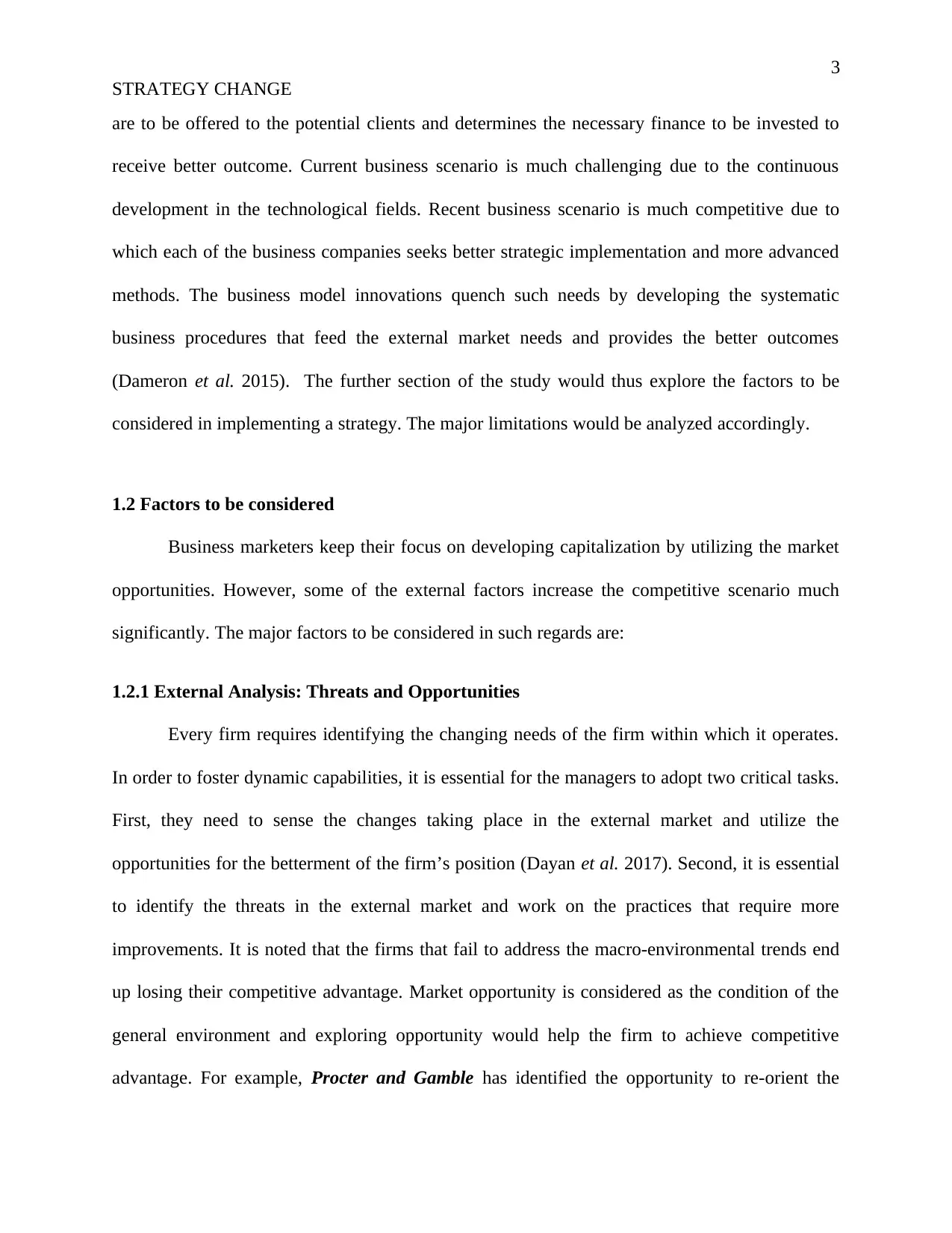
3
STRATEGY CHANGE
are to be offered to the potential clients and determines the necessary finance to be invested to
receive better outcome. Current business scenario is much challenging due to the continuous
development in the technological fields. Recent business scenario is much competitive due to
which each of the business companies seeks better strategic implementation and more advanced
methods. The business model innovations quench such needs by developing the systematic
business procedures that feed the external market needs and provides the better outcomes
(Dameron et al. 2015). The further section of the study would thus explore the factors to be
considered in implementing a strategy. The major limitations would be analyzed accordingly.
1.2 Factors to be considered
Business marketers keep their focus on developing capitalization by utilizing the market
opportunities. However, some of the external factors increase the competitive scenario much
significantly. The major factors to be considered in such regards are:
1.2.1 External Analysis: Threats and Opportunities
Every firm requires identifying the changing needs of the firm within which it operates.
In order to foster dynamic capabilities, it is essential for the managers to adopt two critical tasks.
First, they need to sense the changes taking place in the external market and utilize the
opportunities for the betterment of the firm’s position (Dayan et al. 2017). Second, it is essential
to identify the threats in the external market and work on the practices that require more
improvements. It is noted that the firms that fail to address the macro-environmental trends end
up losing their competitive advantage. Market opportunity is considered as the condition of the
general environment and exploring opportunity would help the firm to achieve competitive
advantage. For example, Procter and Gamble has identified the opportunity to re-orient the
STRATEGY CHANGE
are to be offered to the potential clients and determines the necessary finance to be invested to
receive better outcome. Current business scenario is much challenging due to the continuous
development in the technological fields. Recent business scenario is much competitive due to
which each of the business companies seeks better strategic implementation and more advanced
methods. The business model innovations quench such needs by developing the systematic
business procedures that feed the external market needs and provides the better outcomes
(Dameron et al. 2015). The further section of the study would thus explore the factors to be
considered in implementing a strategy. The major limitations would be analyzed accordingly.
1.2 Factors to be considered
Business marketers keep their focus on developing capitalization by utilizing the market
opportunities. However, some of the external factors increase the competitive scenario much
significantly. The major factors to be considered in such regards are:
1.2.1 External Analysis: Threats and Opportunities
Every firm requires identifying the changing needs of the firm within which it operates.
In order to foster dynamic capabilities, it is essential for the managers to adopt two critical tasks.
First, they need to sense the changes taking place in the external market and utilize the
opportunities for the betterment of the firm’s position (Dayan et al. 2017). Second, it is essential
to identify the threats in the external market and work on the practices that require more
improvements. It is noted that the firms that fail to address the macro-environmental trends end
up losing their competitive advantage. Market opportunity is considered as the condition of the
general environment and exploring opportunity would help the firm to achieve competitive
advantage. For example, Procter and Gamble has identified the opportunity to re-orient the
Paraphrase This Document
Need a fresh take? Get an instant paraphrase of this document with our AI Paraphraser
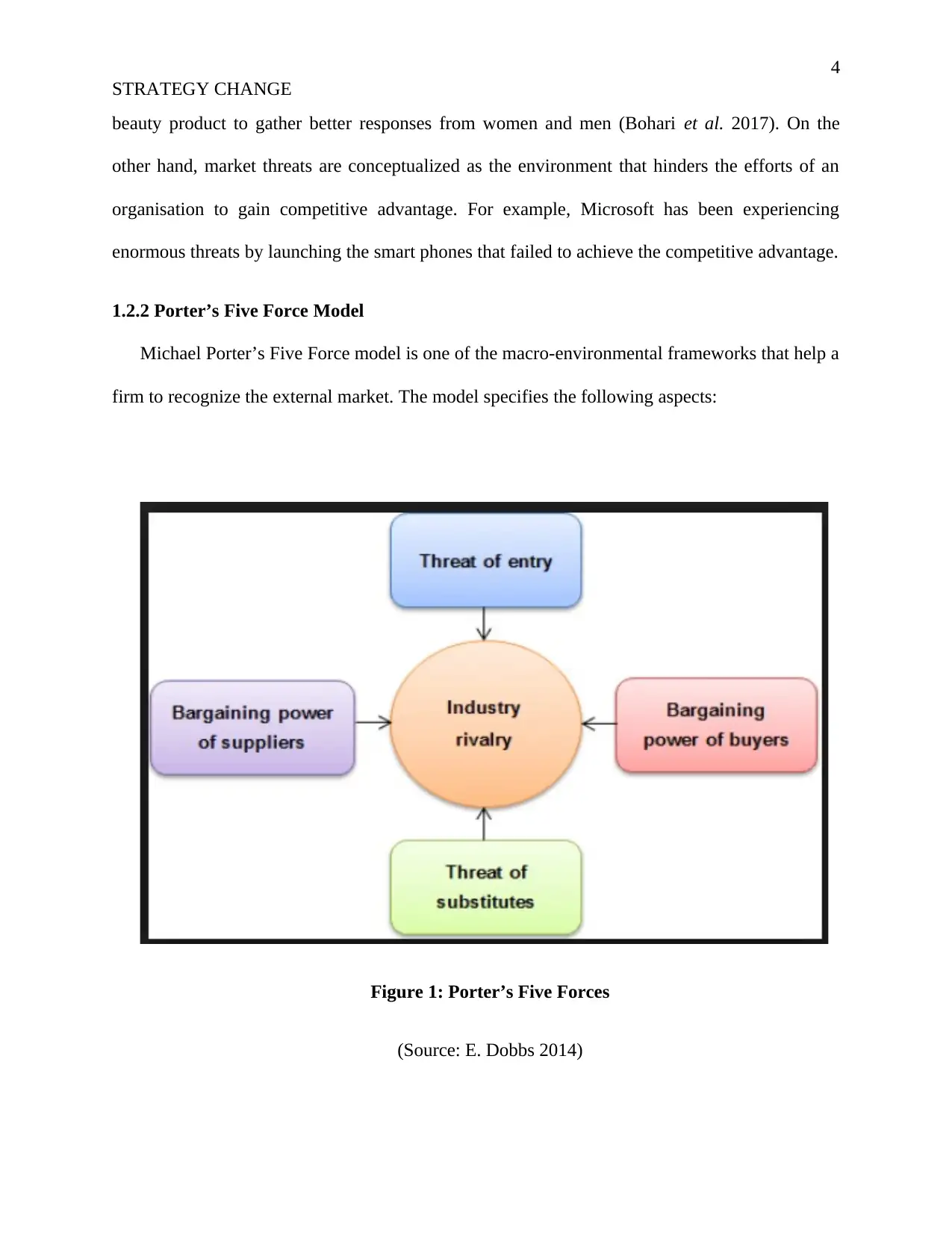
4
STRATEGY CHANGE
beauty product to gather better responses from women and men (Bohari et al. 2017). On the
other hand, market threats are conceptualized as the environment that hinders the efforts of an
organisation to gain competitive advantage. For example, Microsoft has been experiencing
enormous threats by launching the smart phones that failed to achieve the competitive advantage.
1.2.2 Porter’s Five Force Model
Michael Porter’s Five Force model is one of the macro-environmental frameworks that help a
firm to recognize the external market. The model specifies the following aspects:
Figure 1: Porter’s Five Forces
(Source: E. Dobbs 2014)
STRATEGY CHANGE
beauty product to gather better responses from women and men (Bohari et al. 2017). On the
other hand, market threats are conceptualized as the environment that hinders the efforts of an
organisation to gain competitive advantage. For example, Microsoft has been experiencing
enormous threats by launching the smart phones that failed to achieve the competitive advantage.
1.2.2 Porter’s Five Force Model
Michael Porter’s Five Force model is one of the macro-environmental frameworks that help a
firm to recognize the external market. The model specifies the following aspects:
Figure 1: Porter’s Five Forces
(Source: E. Dobbs 2014)
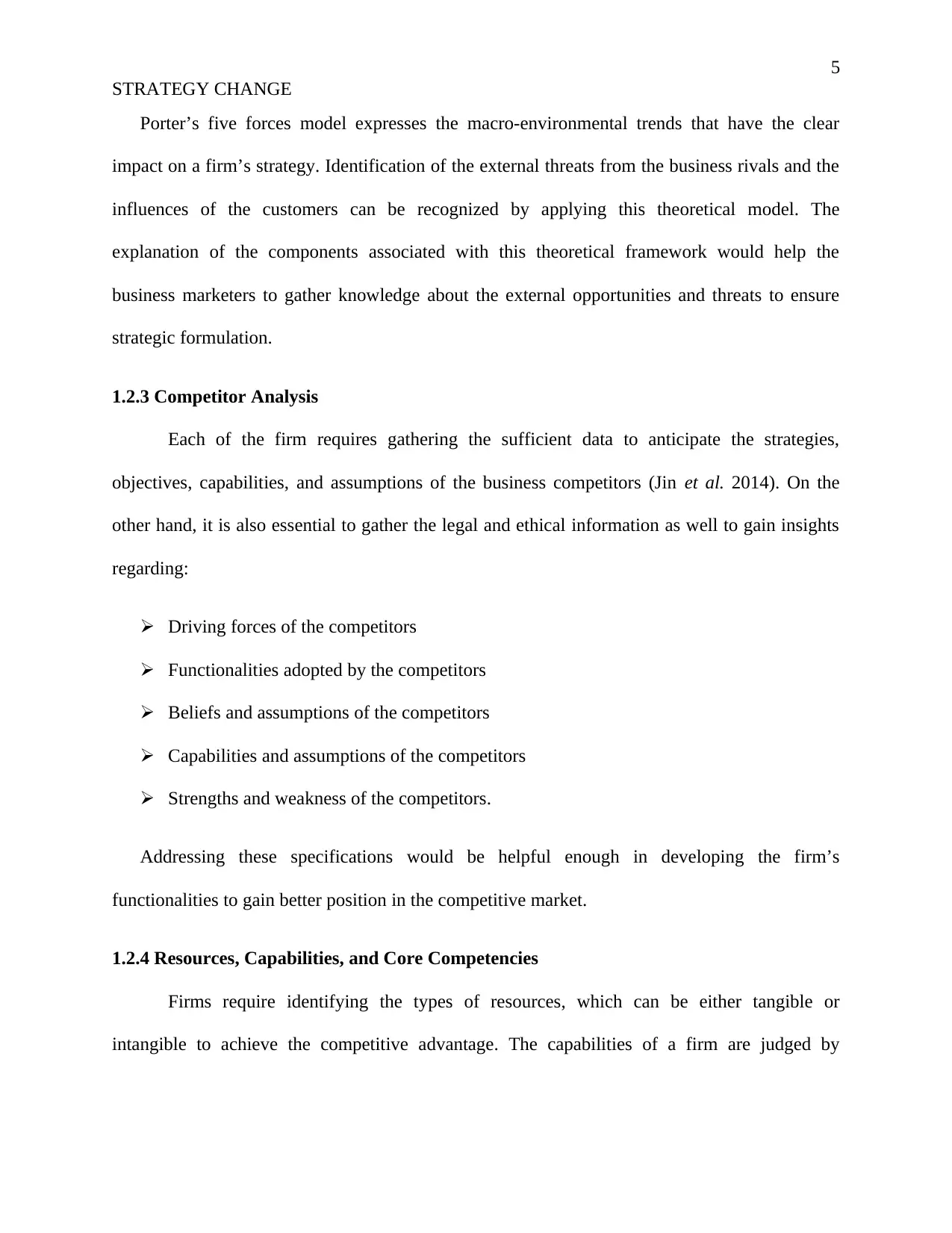
5
STRATEGY CHANGE
Porter’s five forces model expresses the macro-environmental trends that have the clear
impact on a firm’s strategy. Identification of the external threats from the business rivals and the
influences of the customers can be recognized by applying this theoretical model. The
explanation of the components associated with this theoretical framework would help the
business marketers to gather knowledge about the external opportunities and threats to ensure
strategic formulation.
1.2.3 Competitor Analysis
Each of the firm requires gathering the sufficient data to anticipate the strategies,
objectives, capabilities, and assumptions of the business competitors (Jin et al. 2014). On the
other hand, it is also essential to gather the legal and ethical information as well to gain insights
regarding:
Driving forces of the competitors
Functionalities adopted by the competitors
Beliefs and assumptions of the competitors
Capabilities and assumptions of the competitors
Strengths and weakness of the competitors.
Addressing these specifications would be helpful enough in developing the firm’s
functionalities to gain better position in the competitive market.
1.2.4 Resources, Capabilities, and Core Competencies
Firms require identifying the types of resources, which can be either tangible or
intangible to achieve the competitive advantage. The capabilities of a firm are judged by
STRATEGY CHANGE
Porter’s five forces model expresses the macro-environmental trends that have the clear
impact on a firm’s strategy. Identification of the external threats from the business rivals and the
influences of the customers can be recognized by applying this theoretical model. The
explanation of the components associated with this theoretical framework would help the
business marketers to gather knowledge about the external opportunities and threats to ensure
strategic formulation.
1.2.3 Competitor Analysis
Each of the firm requires gathering the sufficient data to anticipate the strategies,
objectives, capabilities, and assumptions of the business competitors (Jin et al. 2014). On the
other hand, it is also essential to gather the legal and ethical information as well to gain insights
regarding:
Driving forces of the competitors
Functionalities adopted by the competitors
Beliefs and assumptions of the competitors
Capabilities and assumptions of the competitors
Strengths and weakness of the competitors.
Addressing these specifications would be helpful enough in developing the firm’s
functionalities to gain better position in the competitive market.
1.2.4 Resources, Capabilities, and Core Competencies
Firms require identifying the types of resources, which can be either tangible or
intangible to achieve the competitive advantage. The capabilities of a firm are judged by
⊘ This is a preview!⊘
Do you want full access?
Subscribe today to unlock all pages.

Trusted by 1+ million students worldwide
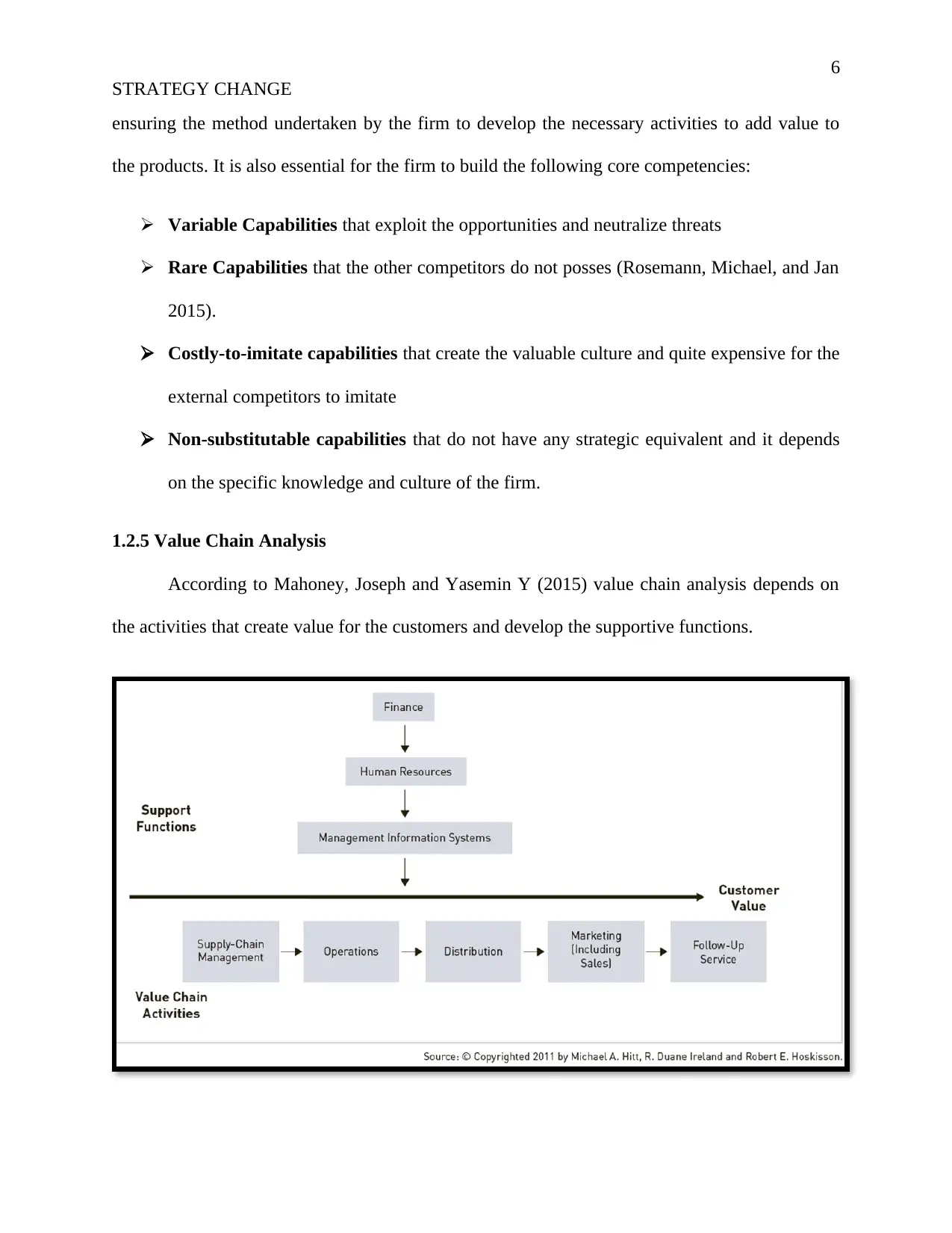
6
STRATEGY CHANGE
ensuring the method undertaken by the firm to develop the necessary activities to add value to
the products. It is also essential for the firm to build the following core competencies:
Variable Capabilities that exploit the opportunities and neutralize threats
Rare Capabilities that the other competitors do not posses (Rosemann, Michael, and Jan
2015).
Costly-to-imitate capabilities that create the valuable culture and quite expensive for the
external competitors to imitate
Non-substitutable capabilities that do not have any strategic equivalent and it depends
on the specific knowledge and culture of the firm.
1.2.5 Value Chain Analysis
According to Mahoney, Joseph and Yasemin Y (2015) value chain analysis depends on
the activities that create value for the customers and develop the supportive functions.
STRATEGY CHANGE
ensuring the method undertaken by the firm to develop the necessary activities to add value to
the products. It is also essential for the firm to build the following core competencies:
Variable Capabilities that exploit the opportunities and neutralize threats
Rare Capabilities that the other competitors do not posses (Rosemann, Michael, and Jan
2015).
Costly-to-imitate capabilities that create the valuable culture and quite expensive for the
external competitors to imitate
Non-substitutable capabilities that do not have any strategic equivalent and it depends
on the specific knowledge and culture of the firm.
1.2.5 Value Chain Analysis
According to Mahoney, Joseph and Yasemin Y (2015) value chain analysis depends on
the activities that create value for the customers and develop the supportive functions.
Paraphrase This Document
Need a fresh take? Get an instant paraphrase of this document with our AI Paraphraser
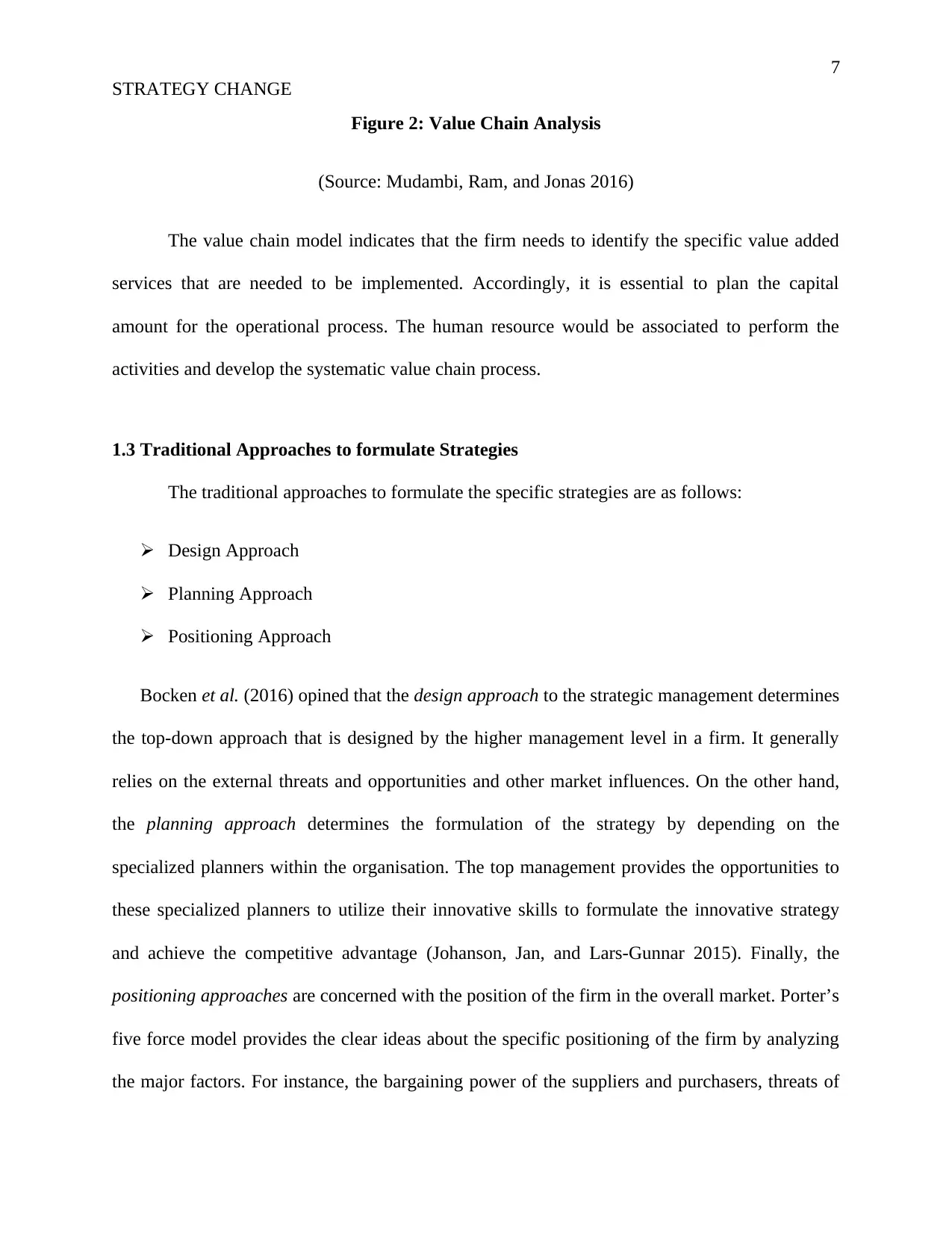
7
STRATEGY CHANGE
Figure 2: Value Chain Analysis
(Source: Mudambi, Ram, and Jonas 2016)
The value chain model indicates that the firm needs to identify the specific value added
services that are needed to be implemented. Accordingly, it is essential to plan the capital
amount for the operational process. The human resource would be associated to perform the
activities and develop the systematic value chain process.
1.3 Traditional Approaches to formulate Strategies
The traditional approaches to formulate the specific strategies are as follows:
Design Approach
Planning Approach
Positioning Approach
Bocken et al. (2016) opined that the design approach to the strategic management determines
the top-down approach that is designed by the higher management level in a firm. It generally
relies on the external threats and opportunities and other market influences. On the other hand,
the planning approach determines the formulation of the strategy by depending on the
specialized planners within the organisation. The top management provides the opportunities to
these specialized planners to utilize their innovative skills to formulate the innovative strategy
and achieve the competitive advantage (Johanson, Jan, and Lars-Gunnar 2015). Finally, the
positioning approaches are concerned with the position of the firm in the overall market. Porter’s
five force model provides the clear ideas about the specific positioning of the firm by analyzing
the major factors. For instance, the bargaining power of the suppliers and purchasers, threats of
STRATEGY CHANGE
Figure 2: Value Chain Analysis
(Source: Mudambi, Ram, and Jonas 2016)
The value chain model indicates that the firm needs to identify the specific value added
services that are needed to be implemented. Accordingly, it is essential to plan the capital
amount for the operational process. The human resource would be associated to perform the
activities and develop the systematic value chain process.
1.3 Traditional Approaches to formulate Strategies
The traditional approaches to formulate the specific strategies are as follows:
Design Approach
Planning Approach
Positioning Approach
Bocken et al. (2016) opined that the design approach to the strategic management determines
the top-down approach that is designed by the higher management level in a firm. It generally
relies on the external threats and opportunities and other market influences. On the other hand,
the planning approach determines the formulation of the strategy by depending on the
specialized planners within the organisation. The top management provides the opportunities to
these specialized planners to utilize their innovative skills to formulate the innovative strategy
and achieve the competitive advantage (Johanson, Jan, and Lars-Gunnar 2015). Finally, the
positioning approaches are concerned with the position of the firm in the overall market. Porter’s
five force model provides the clear ideas about the specific positioning of the firm by analyzing
the major factors. For instance, the bargaining power of the suppliers and purchasers, threats of
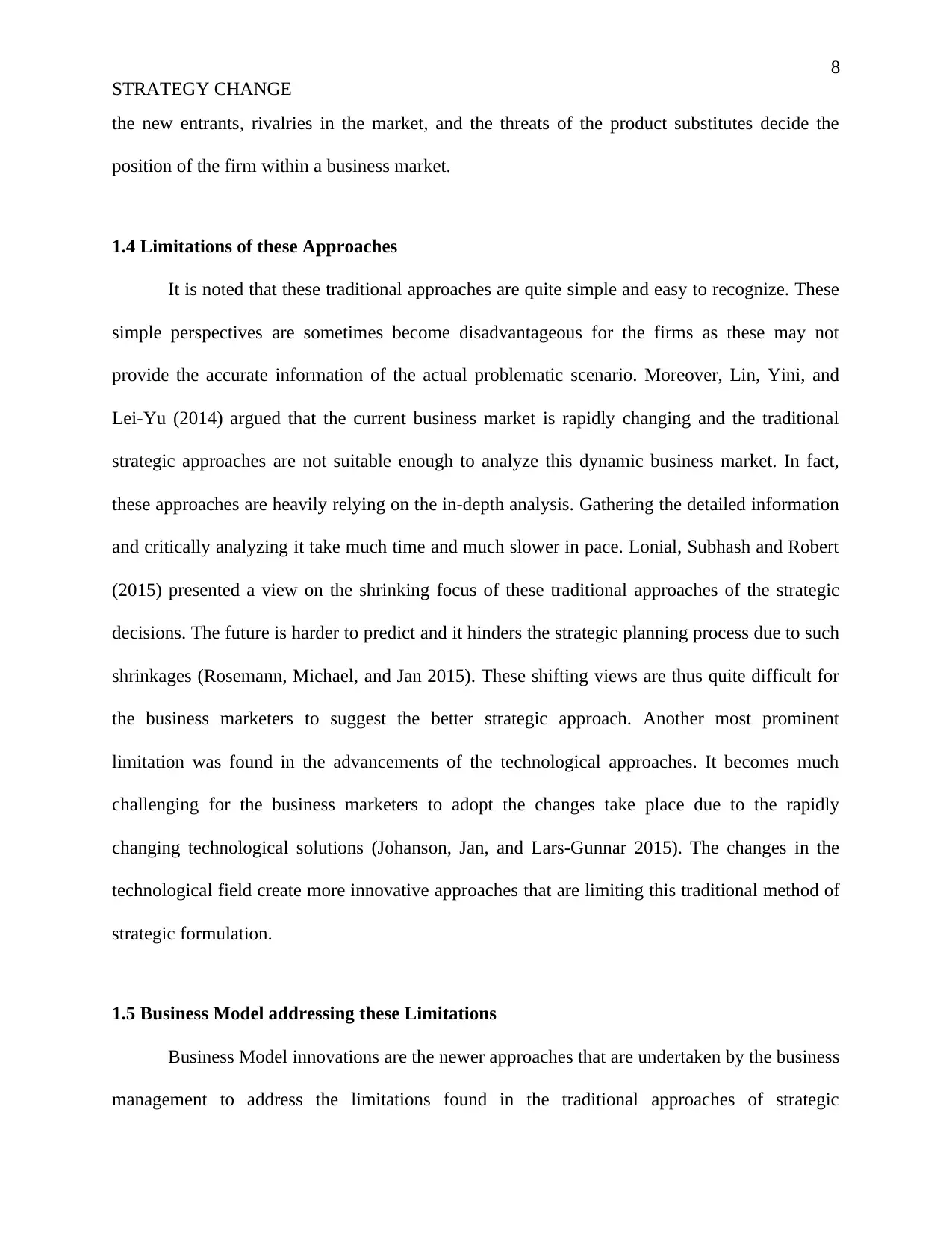
8
STRATEGY CHANGE
the new entrants, rivalries in the market, and the threats of the product substitutes decide the
position of the firm within a business market.
1.4 Limitations of these Approaches
It is noted that these traditional approaches are quite simple and easy to recognize. These
simple perspectives are sometimes become disadvantageous for the firms as these may not
provide the accurate information of the actual problematic scenario. Moreover, Lin, Yini, and
Lei-Yu (2014) argued that the current business market is rapidly changing and the traditional
strategic approaches are not suitable enough to analyze this dynamic business market. In fact,
these approaches are heavily relying on the in-depth analysis. Gathering the detailed information
and critically analyzing it take much time and much slower in pace. Lonial, Subhash and Robert
(2015) presented a view on the shrinking focus of these traditional approaches of the strategic
decisions. The future is harder to predict and it hinders the strategic planning process due to such
shrinkages (Rosemann, Michael, and Jan 2015). These shifting views are thus quite difficult for
the business marketers to suggest the better strategic approach. Another most prominent
limitation was found in the advancements of the technological approaches. It becomes much
challenging for the business marketers to adopt the changes take place due to the rapidly
changing technological solutions (Johanson, Jan, and Lars-Gunnar 2015). The changes in the
technological field create more innovative approaches that are limiting this traditional method of
strategic formulation.
1.5 Business Model addressing these Limitations
Business Model innovations are the newer approaches that are undertaken by the business
management to address the limitations found in the traditional approaches of strategic
STRATEGY CHANGE
the new entrants, rivalries in the market, and the threats of the product substitutes decide the
position of the firm within a business market.
1.4 Limitations of these Approaches
It is noted that these traditional approaches are quite simple and easy to recognize. These
simple perspectives are sometimes become disadvantageous for the firms as these may not
provide the accurate information of the actual problematic scenario. Moreover, Lin, Yini, and
Lei-Yu (2014) argued that the current business market is rapidly changing and the traditional
strategic approaches are not suitable enough to analyze this dynamic business market. In fact,
these approaches are heavily relying on the in-depth analysis. Gathering the detailed information
and critically analyzing it take much time and much slower in pace. Lonial, Subhash and Robert
(2015) presented a view on the shrinking focus of these traditional approaches of the strategic
decisions. The future is harder to predict and it hinders the strategic planning process due to such
shrinkages (Rosemann, Michael, and Jan 2015). These shifting views are thus quite difficult for
the business marketers to suggest the better strategic approach. Another most prominent
limitation was found in the advancements of the technological approaches. It becomes much
challenging for the business marketers to adopt the changes take place due to the rapidly
changing technological solutions (Johanson, Jan, and Lars-Gunnar 2015). The changes in the
technological field create more innovative approaches that are limiting this traditional method of
strategic formulation.
1.5 Business Model addressing these Limitations
Business Model innovations are the newer approaches that are undertaken by the business
management to address the limitations found in the traditional approaches of strategic
⊘ This is a preview!⊘
Do you want full access?
Subscribe today to unlock all pages.

Trusted by 1+ million students worldwide
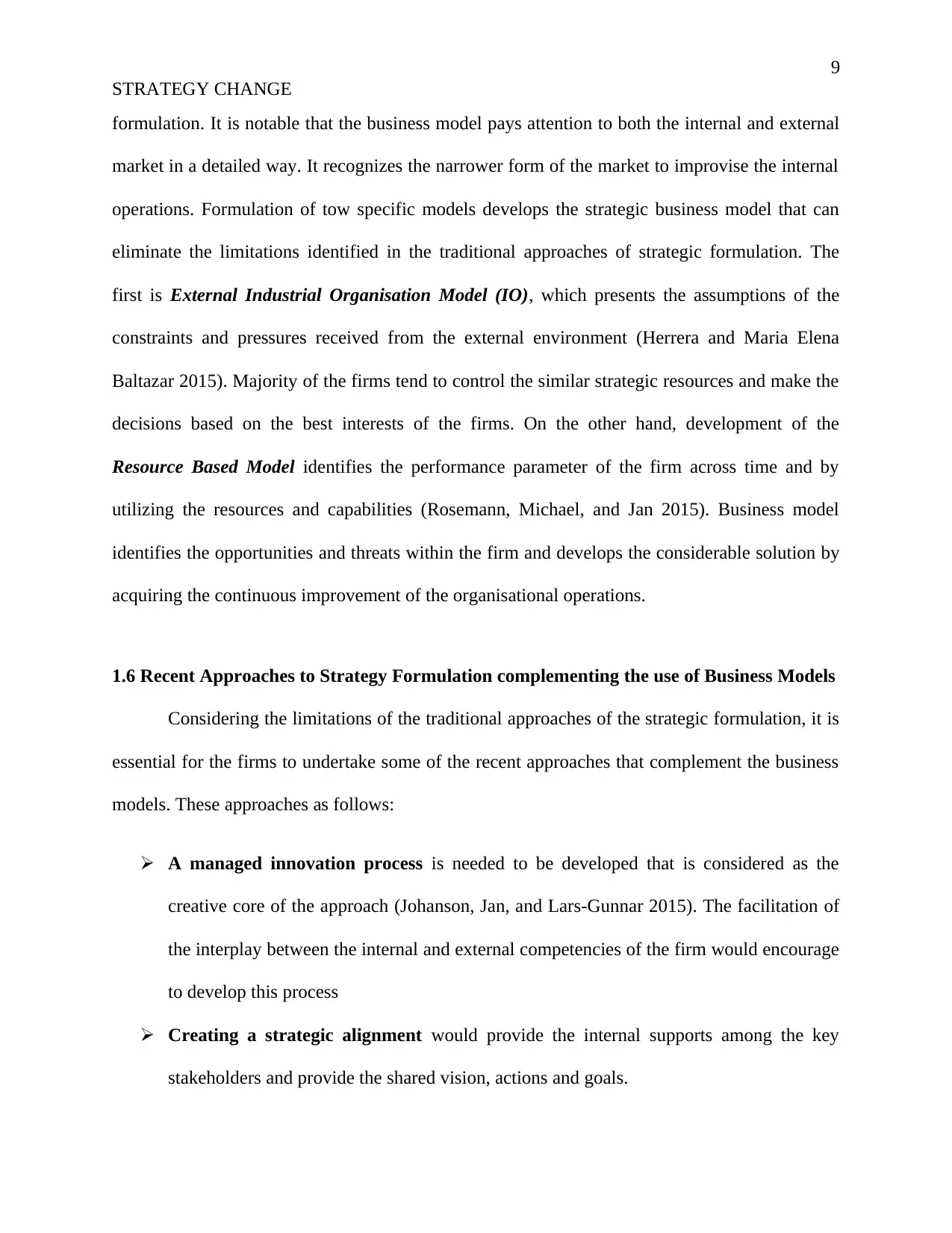
9
STRATEGY CHANGE
formulation. It is notable that the business model pays attention to both the internal and external
market in a detailed way. It recognizes the narrower form of the market to improvise the internal
operations. Formulation of tow specific models develops the strategic business model that can
eliminate the limitations identified in the traditional approaches of strategic formulation. The
first is External Industrial Organisation Model (IO), which presents the assumptions of the
constraints and pressures received from the external environment (Herrera and Maria Elena
Baltazar 2015). Majority of the firms tend to control the similar strategic resources and make the
decisions based on the best interests of the firms. On the other hand, development of the
Resource Based Model identifies the performance parameter of the firm across time and by
utilizing the resources and capabilities (Rosemann, Michael, and Jan 2015). Business model
identifies the opportunities and threats within the firm and develops the considerable solution by
acquiring the continuous improvement of the organisational operations.
1.6 Recent Approaches to Strategy Formulation complementing the use of Business Models
Considering the limitations of the traditional approaches of the strategic formulation, it is
essential for the firms to undertake some of the recent approaches that complement the business
models. These approaches as follows:
A managed innovation process is needed to be developed that is considered as the
creative core of the approach (Johanson, Jan, and Lars-Gunnar 2015). The facilitation of
the interplay between the internal and external competencies of the firm would encourage
to develop this process
Creating a strategic alignment would provide the internal supports among the key
stakeholders and provide the shared vision, actions and goals.
STRATEGY CHANGE
formulation. It is notable that the business model pays attention to both the internal and external
market in a detailed way. It recognizes the narrower form of the market to improvise the internal
operations. Formulation of tow specific models develops the strategic business model that can
eliminate the limitations identified in the traditional approaches of strategic formulation. The
first is External Industrial Organisation Model (IO), which presents the assumptions of the
constraints and pressures received from the external environment (Herrera and Maria Elena
Baltazar 2015). Majority of the firms tend to control the similar strategic resources and make the
decisions based on the best interests of the firms. On the other hand, development of the
Resource Based Model identifies the performance parameter of the firm across time and by
utilizing the resources and capabilities (Rosemann, Michael, and Jan 2015). Business model
identifies the opportunities and threats within the firm and develops the considerable solution by
acquiring the continuous improvement of the organisational operations.
1.6 Recent Approaches to Strategy Formulation complementing the use of Business Models
Considering the limitations of the traditional approaches of the strategic formulation, it is
essential for the firms to undertake some of the recent approaches that complement the business
models. These approaches as follows:
A managed innovation process is needed to be developed that is considered as the
creative core of the approach (Johanson, Jan, and Lars-Gunnar 2015). The facilitation of
the interplay between the internal and external competencies of the firm would encourage
to develop this process
Creating a strategic alignment would provide the internal supports among the key
stakeholders and provide the shared vision, actions and goals.
Paraphrase This Document
Need a fresh take? Get an instant paraphrase of this document with our AI Paraphraser
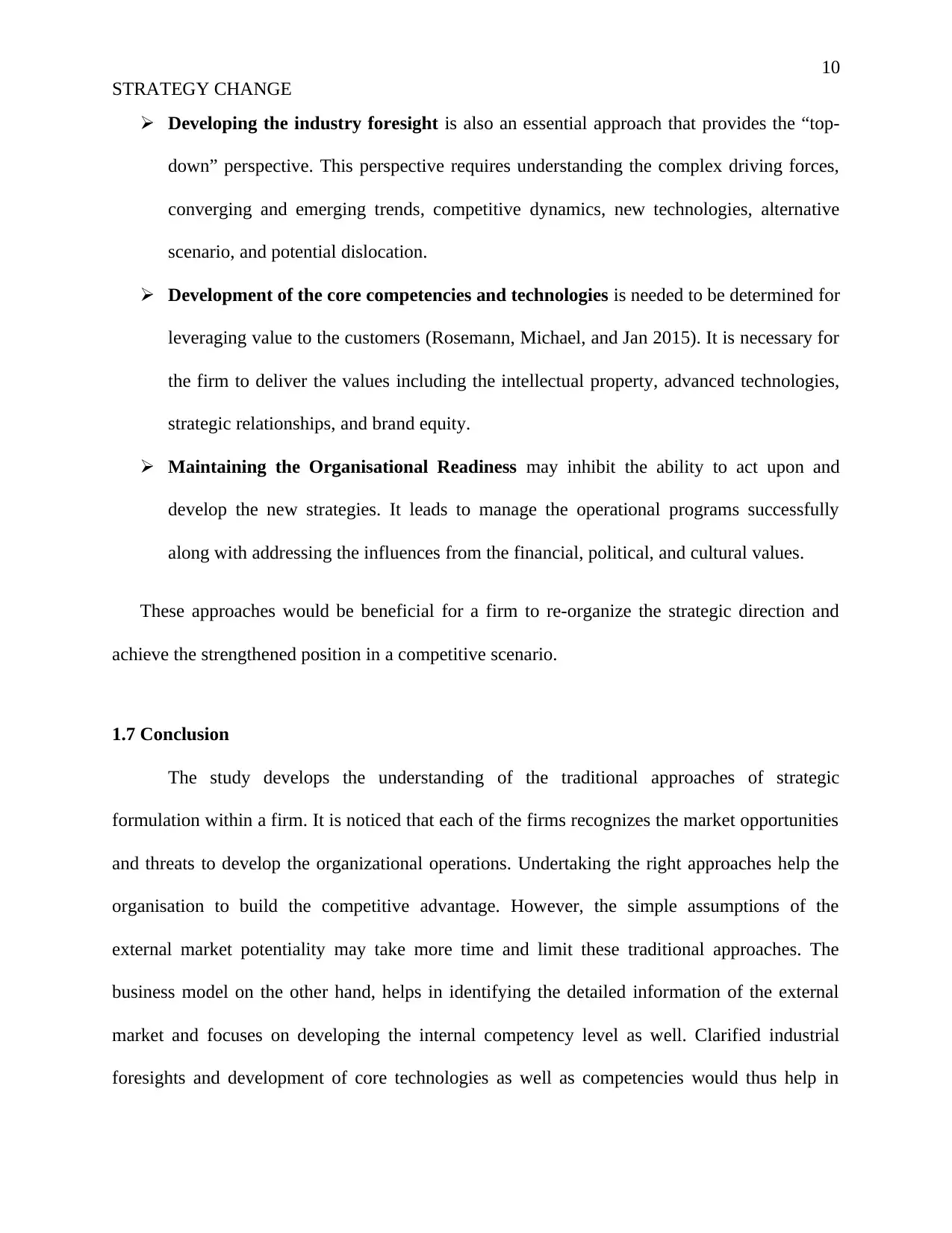
10
STRATEGY CHANGE
Developing the industry foresight is also an essential approach that provides the “top-
down” perspective. This perspective requires understanding the complex driving forces,
converging and emerging trends, competitive dynamics, new technologies, alternative
scenario, and potential dislocation.
Development of the core competencies and technologies is needed to be determined for
leveraging value to the customers (Rosemann, Michael, and Jan 2015). It is necessary for
the firm to deliver the values including the intellectual property, advanced technologies,
strategic relationships, and brand equity.
Maintaining the Organisational Readiness may inhibit the ability to act upon and
develop the new strategies. It leads to manage the operational programs successfully
along with addressing the influences from the financial, political, and cultural values.
These approaches would be beneficial for a firm to re-organize the strategic direction and
achieve the strengthened position in a competitive scenario.
1.7 Conclusion
The study develops the understanding of the traditional approaches of strategic
formulation within a firm. It is noticed that each of the firms recognizes the market opportunities
and threats to develop the organizational operations. Undertaking the right approaches help the
organisation to build the competitive advantage. However, the simple assumptions of the
external market potentiality may take more time and limit these traditional approaches. The
business model on the other hand, helps in identifying the detailed information of the external
market and focuses on developing the internal competency level as well. Clarified industrial
foresights and development of core technologies as well as competencies would thus help in
STRATEGY CHANGE
Developing the industry foresight is also an essential approach that provides the “top-
down” perspective. This perspective requires understanding the complex driving forces,
converging and emerging trends, competitive dynamics, new technologies, alternative
scenario, and potential dislocation.
Development of the core competencies and technologies is needed to be determined for
leveraging value to the customers (Rosemann, Michael, and Jan 2015). It is necessary for
the firm to deliver the values including the intellectual property, advanced technologies,
strategic relationships, and brand equity.
Maintaining the Organisational Readiness may inhibit the ability to act upon and
develop the new strategies. It leads to manage the operational programs successfully
along with addressing the influences from the financial, political, and cultural values.
These approaches would be beneficial for a firm to re-organize the strategic direction and
achieve the strengthened position in a competitive scenario.
1.7 Conclusion
The study develops the understanding of the traditional approaches of strategic
formulation within a firm. It is noticed that each of the firms recognizes the market opportunities
and threats to develop the organizational operations. Undertaking the right approaches help the
organisation to build the competitive advantage. However, the simple assumptions of the
external market potentiality may take more time and limit these traditional approaches. The
business model on the other hand, helps in identifying the detailed information of the external
market and focuses on developing the internal competency level as well. Clarified industrial
foresights and development of core technologies as well as competencies would thus help in
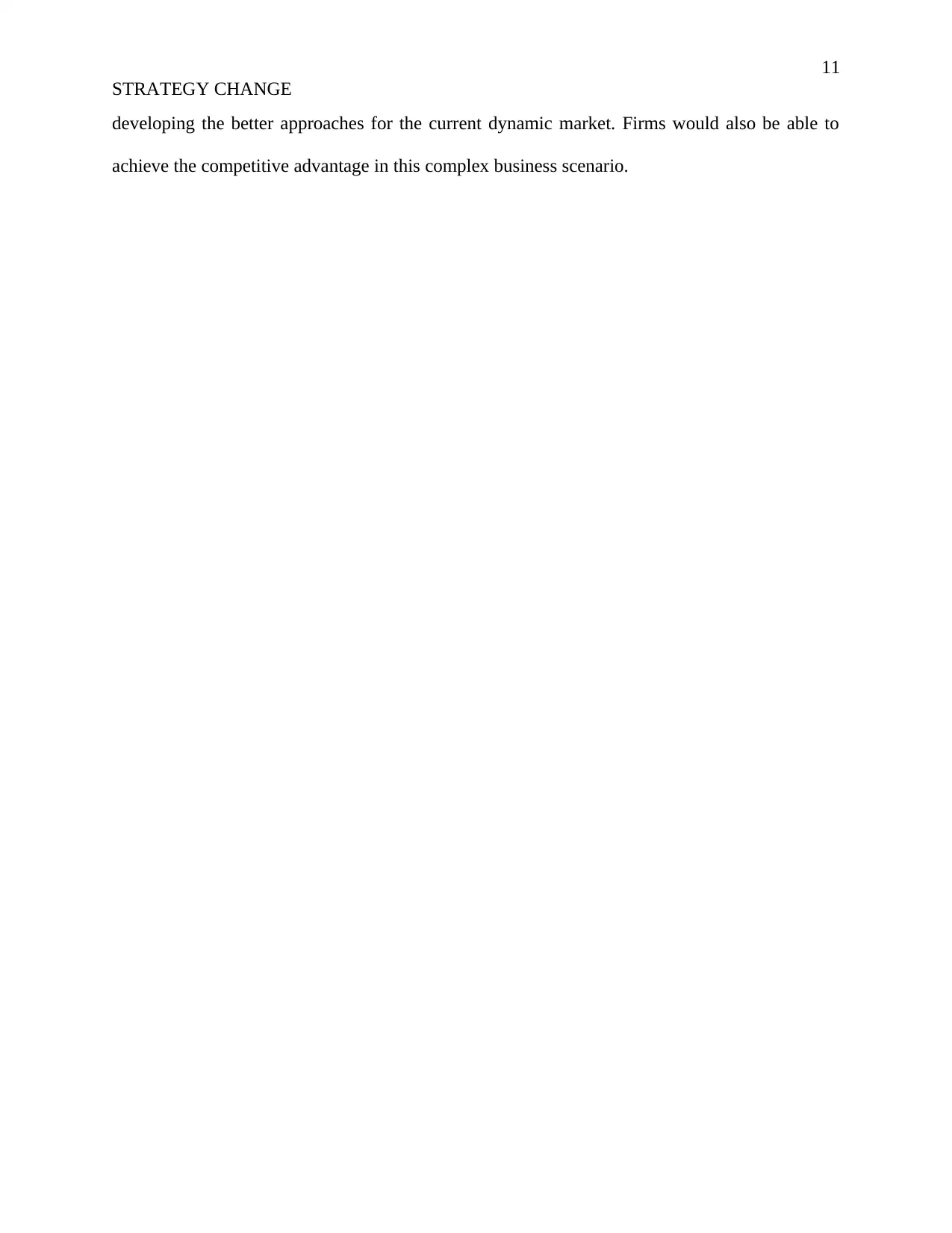
11
STRATEGY CHANGE
developing the better approaches for the current dynamic market. Firms would also be able to
achieve the competitive advantage in this complex business scenario.
STRATEGY CHANGE
developing the better approaches for the current dynamic market. Firms would also be able to
achieve the competitive advantage in this complex business scenario.
⊘ This is a preview!⊘
Do you want full access?
Subscribe today to unlock all pages.

Trusted by 1+ million students worldwide
1 out of 15
Related Documents
Your All-in-One AI-Powered Toolkit for Academic Success.
+13062052269
info@desklib.com
Available 24*7 on WhatsApp / Email
![[object Object]](/_next/static/media/star-bottom.7253800d.svg)
Unlock your academic potential
Copyright © 2020–2025 A2Z Services. All Rights Reserved. Developed and managed by ZUCOL.





